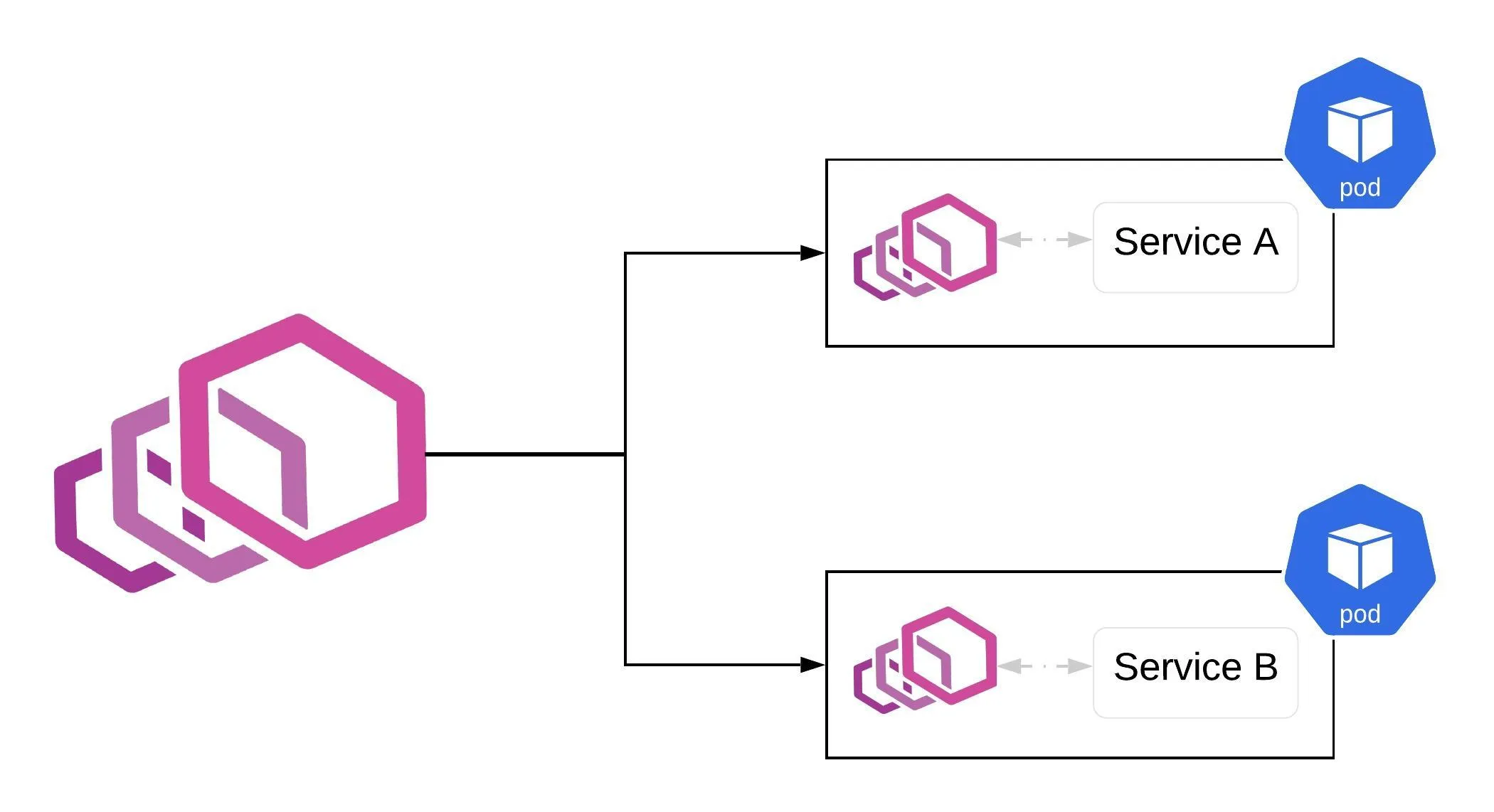Table of Contents
- Pre-requisites
- Sidecar Deployment
- Headless Service Configuration
- Front Envoy Configuration
- Testing
- References
Pre-requisites

Learn How to Master Digital Trust

The State of Consumer Digital ID 2024

Top CIAM Platform 2024
This post will cover a demo working setup of a service mesh architecture using Envoy using a demo application. In this service mesh architecture, we will be using Envoy proxy for both control and data plane. The setup is deployed in a Kubernetes cluster using Amazon EKS.
Pre-requisites
We will be deploying an echo-grpc test application provided by Google in their article related to gRPC load balancing and was used as a reference to test the service mesh setup with Envoy. The article covers setting up Envoy as an edge proxy only. This is a simple gRPC application that exposes a unary method that takes a string in the content request field and responds with the content unaltered. Repo: grpc-gke-nlb-tutorial
- Clone this repo.
- Go to the echo-grpc directory.
- Using the Dockerfile provided in the folder, we would have to build the image and push it to the Docker registry of choice. Since we are not using GCP, Docker Hub is used as the registry.
- Run docker login and login with your hub credentials.
- Build the image docker build -t echo-grpc .
- Tag the image docker tag echo-grpc /echo-grpc
- Push the image docker push /echo-grpc
- Create a separate folder to put all the YAML files.
- Create namespace in k8s:
kubectl create namespace envoy - Install grpcurl tool which is similar to curl but for gRPC for testing:
go get github.com/fullstorydev/grpcurl
Sidecar Deployment
Configuration of envoy for the sidecar deployment:
envoy-echo.yaml:
1apiVersion: v1
2kind: ConfigMap
3metadata:
4 name: envoy-echo
5data:
6 envoy.yaml: |
7 static_resources:
8 listeners:
9 - address:
10 socket_address:
11 address: 0.0.0.0
12 port_value: 8786
13 filter_chains:
14 - filters:
15 - name: envoy.http_connection_manager
16 config:
17 access_log:
18 - name: envoy.file_access_log
19 config:
20 path: "/dev/stdout"
21 codec_type: AUTO
22 stat_prefix: ingress_https
23 route_config:
24 name: local_route
25 virtual_hosts:
26 - name: https
27 domains:
28 - "*"
29 routes:
30 - match:
31 prefix: "/api.Echo/"
32 route:
33 cluster: echo-grpc
34 http_filters:
35 - name: envoy.health_check
36 config:
37 pass_through_mode: false
38 headers:
39 - name: ":path"
40 exact_match: "/healthz"
41 - name: "x-envoy-livenessprobe"
42 exact_match: "healthz"
43 - name: envoy.router
44 config: {}
45 clusters:
46 - name: echo-grpc
47 connect_timeout: 0.5s
48 type: STATIC
49 lb_policy: ROUND_ROBIN
50 http2_protocol_options: {}
51 load_assignment:
52 cluster_name: echo-grpc
53 endpoints:
54 - lb_endpoints:
55 - endpoint:
56 address:
57 socket_address:
58 address: "127.0.0.1"
59 port_value: 8081
60 health_checks:
61 timeout: 1s
62 interval: 10s
63 unhealthy_threshold: 2
64 healthy_threshold: 2
65 grpc_health_check: {}
66 admin:
67 access_log_path: "/dev/stdout"
68 address:
69 socket_address:
70 address: 127.0.0.1
71 port_value: 8090A couple things to note here.
- We are exposing sidecar on 8786 port on the container.
- Filter envoy.http_connection_manager handles the HTTP traffic.
- route_config is used to define the routes for each domain to their respective clusters. Here we are keeping the domain as
*, allowing all domains to pass-through. - A cluster is envoy defines the services that will be called based on the route.
- In the cluster, the lb_policy defines the algorithm for load balancing, keeping as ROUND_ROBIN, with type STATIC because it is a sidecar and needs to communicate to only one pod always which leads to the reason for keeping the address in socket_address as localhost while port_value is what will be exposed by that particular service’s deployment.
Run:
kubectl apply -f envoy-echo.yaml -n envoy
Deployment of echo-grpc application with 3 replicas. The config contains two containers, one for application and another being the Envoy image.
1apiVersion: apps/v1
2kind: Deployment
3metadata:
4 name: echo-grpc
5spec:
6 replicas: 3
7 selector:
8 matchLabels:
9 app: echo-grpc
10 template:
11 metadata:
12 labels:
13 app: echo-grpc
14 spec:
15 containers:
16 - name: echo-grpc
17 image: <hub-username>/echo-grpc
18 imagePullPolicy: Always
19 resources: {}
20 env:
21 - name: "PORT"
22 value: "8081"
23 ports:
24 - containerPort: 8081
25 readinessProbe:
26 exec:
27 command: ["/bin/grpc_health_probe", "-addr=:8081"]
28 initialDelaySeconds: 1
29 livenessProbe:
30 exec:
31 command: ["/bin/grpc_health_probe", "-addr=:8081"]
32 initialDelaySeconds: 1
33 - name: envoy
34 image: envoyproxy/envoy:v1.9.1
35 resources: {}
36 ports:
37 - name: https
38 containerPort: 443
39 volumeMounts:
40 - name: config
41 mountPath: /etc/envoy
42 volumes:
43 - name: config
44 configMap:
45 name: envoy-echoHere, echo-grpc is test application and envoy is being deployed in the same pod. Config volumes are mounted so that the envoy can read the configmaps.
Run:
kubectl apply -f echo-deployment.yaml -n envoy
Headless Service Configuration
We are using headless service for echo-grpc. Using service as headless will expose the Pods IP to the DNS server of kubernetes which will be used by Envoy to do service discovery for the pods.
echo-service.yaml
1apiVersion: v1
2kind: Service
3metadata:
4 name: echo-grpc
5spec:
6 type: ClusterIP
7 clusterIP: None
8 selector:
9 app: echo-grpc
10 ports:
11 - name: http2-echo
12 protocol: TCP
13 port: 8786
14 - name: http2-service
15 protocol: TCP
16 port: 8081In the above config file, we are exposing two ports, one for envoy sidecar (this is the same port we mentioned in the config map of sidecar envoy) and one for the service itself.
Run:
kubectl apply -f echo-service.yaml -n envoy
Front Envoy Configuration
Creating a service of type LoadBalancer so that client can access the backend service.
envoy-service.yaml:
1apiVersion: v1
2kind: Service
3metadata:
4 name: envoy
5spec:
6 type: LoadBalancer
7 selector:
8 app: envoy
9 ports:
10 - name: https
11 protocol: TCP
12 port: 443
13 targetPort: 443Creating self-signed certificates
Run:
kubectl apply -f envoy-service.yaml -n envoy
Since we are deploying front envoy LoadBalancer on port 443, we have to create a self-signed certificate to make it terminate SSL/TLS connection.
-
Get the external IP:
kubectl describe svc/envoy -n envoy -
Copy the LoadBalancer address in the EXTERNAL-IP section and do a nslookup and copy the IP address:
nslookup <your load balancer aadess> -
Create a self-signed cert and key:
openssl req -x509 -nodes -newkey rsa:2048 -days 365 -keyout privkey.pem -out cert.pem -subj "/CN=<ip-address>" -
Create a Kubernetes TLS Secret called envoy-certs that contains the self-signed SSL/TLS certificate and key:
kubectl create secret tls envoy-certs --key privkey.pem --cert cert.pem --dry-run -o yaml
Edge Envoy configuration
Configuration for the edge Envoy:
envoy-configmap.yaml
1apiVersion: v1
2kind: ConfigMap
3metadata:
4 name: envoy-conf
5data:
6 envoy.yaml: |
7 static_resources:
8 listeners:
9 - address:
10 socket_address:
11 address: 0.0.0.0
12 port_value: 443
13 filter_chains:
14 - filters:
15 - name: envoy.http_connection_manager
16 config:
17 access_log:
18 - name: envoy.file_access_log
19 config:
20 path: "/dev/stdout"
21 codec_type: AUTO
22 stat_prefix: ingress_https
23 route_config:
24 name: local_route
25 virtual_hosts:
26 - name: https
27 domains:
28 - "*"
29 routes:
30 - match:
31 prefix: "/api.Echo/"
32 route:
33 cluster: echo-grpc
34 http_filters:
35 - name: envoy.health_check
36 config:
37 pass_through_mode: false
38 headers:
39 - name: ":path"
40 exact_match: "/healthz"
41 - name: "x-envoy-livenessprobe"
42 exact_match: "healthz"
43 - name: envoy.router
44 config: {}
45 tls_context:
46 common_tls_context:
47 tls_certificates:
48 - certificate_chain:
49 filename: "/etc/ssl/envoy/tls.crt"
50 private_key:
51 filename: "/etc/ssl/envoy/tls.key"
52 clusters:
53 - name: echo-grpc
54 connect_timeout: 0.5s
55 type: STRICT_DNS
56 lb_policy: ROUND_ROBIN
57 http2_protocol_options: {}
58 load_assignment:
59 cluster_name: echo-grpc
60 endpoints:
61 - lb_endpoints:
62 - endpoint:
63 address:
64 socket_address:
65 address: echo-grpc.envoy.svc.cluster.local
66 port_value: 8786
67 health_checks:
68 timeout: 1s
69 interval: 10s
70 unhealthy_threshold: 2
71 healthy_threshold: 2
72 grpc_health_check: {}
73 admin:
74 access_log_path: "/dev/stdout"
75 address:
76 socket_address:
77 address: 127.0.0.1
78 port_value: 8090Since we will be offloading HTTPS, we are using port_value of 443. Most of the configurations are same as of sidecar envoy except for three things:
- A tls_context config is required to mention the tls certifications needed for authentication purposes.
- In clusters, the type has been to STATIC to STRICT_DNS which is a kind of service discovery mechanism making use of Headless service we deployed earlier.
- The socket_address’s address value has been changed to the FQDN of the service.
Run:
kubectl apply -f envoy-configmap.yaml -n envoy
Deployment Configuration
envoy-deployment.yaml
1apiVersion: apps/v1
2kind: Deployment
3metadata:
4 name: envoy
5spec:
6 replicas: 2
7 selector:
8 matchLabels:
9 app: envoy
10 template:
11 metadata:
12 labels:
13 app: envoy
14 spec:
15 containers:
16 - name: envoy
17 image: envoyproxy/envoy:v1.9.1
18 resources: {}
19 ports:
20 - name: https
21 containerPort: 443
22 volumeMounts:
23 - name: config
24 mountPath: /etc/envoy
25 - name: certs
26 mountPath: /etc/ssl/envoy
27 readinessProbe:
28 httpGet:
29 scheme: HTTPS
30 path: /healthz
31 httpHeaders:
32 - name: x-envoy-livenessprobe
33 value: healthz
34 port: 443
35 initialDelaySeconds: 3
36 livenessProbe:
37 httpGet:
38 scheme: HTTPS
39 path: /healthz
40 httpHeaders:
41 - name: x-envoy-livenessprobe
42 value: healthz
43 port: 443
44 initialDelaySeconds: 10
45 volumes:
46 - name: config
47 configMap:
48 name: envoy-conf
49 - name: certs
50 secret:
51 secretName: envoy-certsRun:
kubectl apply -f envoy-deployment.yaml -n envoy
Testing
Proto file for the echo-grpc service:
ccho.proto:
1syntax = "proto3";
2package api;
3service Echo {
4rpc Echo (EchoRequest) returns (EchoResponse) {}
5}
6message EchoRequest {
7string content = 1;
8}
9message EchoResponse {
10string content = 1;
11}Run the following command to call the server:
grpcurl -d '{"content": "echo"}' -proto echo.proto -insecure -v <load_balancer_or_external_ip>:443 api.Echo/Echo
The output will be similar to something like this:
1Resolved method descriptor:
2rpc Echo ( .api.EchoRequest ) returns ( .api.EchoResponse );
3Request metadata to send:
4(empty)
5Response headers received:
6content-type: application/grpc
7date: Wed, 27 Feb 2019 04:40:19 GMT
8hostname: echo-grpc-5c4f59c578-wcsvr
9server: envoy
10x-envoy-upstream-service-time: 0
11Response contents:
12{
13"content": "echo"
14}
15Response trailers received:
16(empty)
17Sent 1 request and received 1 responseRun the above command multiple times and check the value of the hostname field every time which will contain the pod name of one of the 3 pods deployed.
References

Featured Posts
Introducing Identity Studio: AI-Crafted Login Experiences, Built in Minutes!
How SAML Authentication Powers Modern Single Sign-On
How LoginRadius Maintained 100% Uptime During the AWS US-EAST-1 Outage
SaaS Identity & Access Management: Multi-Tenant Best Practices
Why Most Mobile Apps Fail at Authentication (and How to Fix It)
Improve User Experience with Single Sign-On in Salesforce
WordPress Social Login: Simplify Sign-Ups in One Click
SSO Authentication: Complete Guide to OpenID, SAML & OAuth
A Developer’s Guide to Centralized Identity Management
TOTP Authentication Explained: How It Works, Why It’s Secure
Advantages of Time-Based One-Time Passwords (TOTP)
JWT Authentication with LoginRadius: Quick Integration Guide
Complete Guide to JSON Web Token (JWT) and How It Works
OAuth 2.0 Explained: A Complete Guide to Flows, Tokens, and Modern Authorization
How Chrome’s Third-Party Cookie Restrictions Affect User Authentication?
How to Implement OpenID Connect (OIDC) SSO with LoginRadius?
Testing Brute-force Lockout with LoginRadius
Breaking Down the Decision: Why We Chose AWS ElastiCache Over Redis Cloud
LoginRadius Launches a CLI for Enterprise Dashboard
How to Implement JWT Authentication for CRUD APIs in Deno
Multi-Factor Authentication (MFA) with Redis Cache and OTP
Introduction to SolidJS
Why We Re-engineered LoginRadius APIs with Go?
Why B2B Companies Should Implement Identity Management
Top 10 Cyber Threats in 2022
Build a Modern Login/Signup Form with Tailwind CSS and React
M2M Authorization: Authenticate Apps, APIs, and Web Services
Implement HTTP Streaming with Node.js and Fetch API
NestJS: How to Implement Session-Based User Authentication
How to Integrate Invisible reCAPTCHA for Bot Protection
How Lapsus$ Breached Okta and What Organizations Should Learn
NestJS User Authentication with LoginRadius API
How to Authenticate Svelte Apps
How to Build Your Github Profile
Why Implement Search Functionality for Your Websites
Flutter Authentication: Implementing User Signup and Login
How to Secure Your LoopBack REST API with JWT Authentication
When Can Developers Get Rid of Password-based Authentication?
4 Ways to Extend CIAM Capabilities of BigCommerce
Node.js User Authentication Guide
Your Ultimate Guide to Next.js Authentication
Local Storage vs. Session Storage vs. Cookies
How to Secure a PHP API Using JWT
React Security Vulnerabilities and How to Fix/Prevent Them
Cookie-based vs. Cookieless Authentication: What’s the Future?
Using JWT Flask JWT Authentication- A Quick Guide
Single-Tenant vs. Multi-Tenant: Which SaaS Architecture is better for Your Business?
Build Your First Smart Contract with Ethereum & Solidity
What are JWT, JWS, JWE, JWK, and JWA?
How to Build an OpenCV Web App with Streamlit
32 React Best Practices That Every Programmer Should Follow
How to Build a Progressive Web App (PWA) with React
Bootstrap 4 vs. Bootstrap 5: What is the Difference?
JWT Authentication — Best Practices and When to Use
What Are Refresh Tokens? When & How to Use Them
How to Participate in Hacktoberfest as a Maintainer
How to Upgrade Your Vim Skills
Hacktoberfest 2021: Contribute and Win Swag from LoginRadius
How to Implement Role-Based Authentication with React Apps
How to Authenticate Users: JWT vs. Session
How to Use Azure Key Vault With an Azure Web App in C#
How to Implement Registration and Authentication in Django?
11 Tips for Managing Remote Software Engineering Teams
One Vision, Many Paths: How We’re Supporting freeCodeCamp
C## Init-Only Setters Property
Content Security Policy (CSP)
Implementing User Authentication in a Python Application
Introducing LoginRadius CLI
Add Authentication to Play Framework With OIDC and LoginRadius
React renderers, react everywhere?
React's Context API Guide with Example
Implementing Authentication on Vue.js using JWTtoken
How to create and use the Dictionary in C#
What is Risk-Based Authentication? And Why Should You Implement It?
React Error Boundaries
Data Masking In Nginx Logs For User Data Privacy And Compliance
Code spliting in React via lazy and suspense
Implement Authentication in React Applications using LoginRadius CLI
What is recoil.js and how it is managing in react?
How Enum.TryParse() works in C#
React with Ref
Implement Authentication in Angular 2+ application using LoginRadius CLI in 5 mins
How Git Local Repository Works
How to add SSO for your WordPress Site!
Guide to Authorization Code Flow for OAuth 2.0
Introduction to UniFi Ubiquiti Network
The Upcoming Future of Software Testers and SDETs in 2021
Why You Need an Effective Cloud Management Platform
What is Adaptive Authentication or Risk-based Authentication?
Top 9 Challenges Faced by Every QA
Top 4 Serverless Computing Platforms in 2021
QA Testing Process: How to Deliver Quality Software
How to Create List in C#
What is a DDoS Attack and How to Mitigate it
How to Verify Email Addresses in Google Sheet
Concurrency vs Parallelism: What's the Difference?
35+ Git Commands List Every Programmer Should Know
How to do Full-Text Search in MongoDB
What is API Testing? - Discover the Benefits
The Importance of Multi-Factor Authentication (MFA)
Optimize Your Sign Up Page By Going Passwordless
Image Colorizer Tool - Kolorizer
PWA vs Native App: Which one is Better for you?
How to Deploy a REST API in Kubernetes
Integration with electronic identity (eID)
How to Work with Nullable Types in C#
Git merge vs. Git Rebase: What's the difference?
How to Install and Configure Istio
How to Perform Basic Query Operations in MongoDB
Invalidating JSON Web Tokens
How to Use the HTTP Client in GO To Enhance Performance
Constructor vs getInitialState in React
Web Workers in JS - An Introductory Guide
How to Use Enum in C#
How to Migrate Data In MongoDB
A Guide To React User Authentication with LoginRadius
WebAuthn: A Guide To Authenticate Your Application
Build and Push Docker Images with Go
Istio Service Mesh: A Beginners Guide
How to Perform a Git Force Pull
NodeJS Server using Core HTTP Module
How does bitwise ^ (XOR) work?
Introduction to Redux Saga
React Router Basics: Routing in a Single-page Application
How to send emails in C#/.NET using SMTP
How to create an EC2 Instance in AWS
How to use Git Cherry Pick
Password Security Best Practices & Compliance
Using PGP Encryption with Nodejs
Python basics in minutes
Automating Rest API's using Cucumber and Java
Bluetooth Controlled Arduino Car Miniature
AWS Services-Walkthrough
Beginners Guide to Tweepy
Introduction to Github APIs
Introduction to Android Studio
Login Screen - Tips and Ideas for Testing
Introduction to JAMstack
A Quick Look at the React Speech Recognition Hook
IoT and AI - The Perfect Match
A Simple CSS3 Accordion Tutorial
EternalBlue: A retrospective on one of the biggest Windows exploits ever
Setup a blog in minutes with Jekyll & Github
What is Kubernetes? - A Basic Guide
Why RPA is important for businesses
Best Hacking Tools
Three Ways to do CRUD Operations On Redis
Traversing the realms of Quantum Network
How to make a telegram bot
iOS App Development: How To Make Your First App
Apache Beam: A Basic Guide
Python Virtual Environment: What is it and how it works?
End-to-End Testing with Jest and Puppeteer
Speed Up Python Code
Build A Twitter Bot Using NodeJS
Visualizing Data using Leaflet and Netlify
STL Containers & Data Structures in C++
Secure Enclave in iOS App
Optimal clusters for KMeans Algorithm
Upload files using NodeJS + Multer
Class Activation Mapping in Deep Learning
Full data science pipeline implementation
HTML Email Concept
Blockchain: The new technology of trust
Vim: What is it and Why to use it?
Virtual Dispersive Networking
React Context API: What is it and How it works?
Breaking down the 'this' keyword in Javascript
Handling the Cheapest Fuel- Data
GitHub CLI Tool ⚒
Lazy loading in React
What is GraphQL? - A Basic Guide
Exceptions and Exception Handling in C#
Unit Testing: What is it and why do you need it?
Golang Maps - A Beginner’s Guide
LoginRadius Open Source For Hacktoberfest 2020
JWT Signing Algorithms
How to Render React with optimization
Ajax and XHR using plain JS
Using MongoDB as Datasource in GoLang
Understanding event loop in JavaScript
LoginRadius Supports Hacktoberfest 2020
How to implement Facebook Login
Production Grade Development using Docker-Compose
Web Workers: How to add multi-threading in JS
Angular State Management With NGXS
What's new in the go 1.15
Let’s Take A MEME Break!!!
PKCE: What it is and how to use it with OAuth 2.0
Big Data - Testing Strategy
Email Verification API (EVA)
Implement AntiXssMiddleware in .NET Core Web
Setting Up and Running Apache Kafka on Windows OS
Getting Started with OAuth 2.0
Best Practice Guide For Rest API Security | LoginRadius
Let's Write a JavaScript Library in ES6 using Webpack and Babel
Cross Domain Security
Best Free UI/UX Design Tools/Resources 2020
A journey from Node to GoLang
React Hooks: A Beginners Guide
DESIGN THINKING -A visual approach to understand user’s needs
Deep Dive into Container Security Scanning
Different ways to send an email with Golang
Snapshot testing using Nightwatch and mocha
Qualities of an agile development team
IAM, CIAM, and IDaaS - know the difference and terms used for them
How to obtain iOS application logs without Mac
Benefits and usages of Hosts File
React state management: What is it and why to use it?
HTTP Security Headers
Sonarqube: What it is and why to use it?
How to create and validate JSON Web Tokens in Deno
Cloud Cost Optimization in 2021
Service Mesh with Envoy
Kafka Streams: A stream processing guide
Self-Hosted MongoDB
Roadmap of idx-auto-tester
How to Build a PWA in Vanilla JS
Password hashing with NodeJS
Introduction of Idx-Auto-Tester
Twitter authentication with Go Language and Goth
Google OAuth2 Authentication in Golang
LinkedIn Login using Node JS and passport
Read and Write in a local file with Deno
Build A Simple CLI Tool using Deno
Create REST API using deno
Automation for Identity Experience Framework is now open-source !!!
Creating a Web Application using Deno
Hello world with Deno
Facebook authentication using NodeJS and PassportJS
StackExchange - The 8 best resources every developer must follow
OAuth implementation with Node.js and Github
NodeJS and MongoDB application authentication by JWT
Working with AWS Lambda and SQS
Google OAuth2 Authentication in NodeJS - A Guide to Implementing OAuth in Node.js
Custom Encoders in the Mongo Go Driver
React's Reconciliation Algorithm
NaN in JavaScript: An Essential Guide
SDK Version 10.0.0
Getting Started with gRPC - Part 1 Concepts
Introduction to Cross-Site Request Forgery (CSRF)
Introduction to Web Accessibility with Semantic HTML5
JavaScript Events: Bubbling, Capturing, and Propagation
3 Simple Ways to Secure Your Websites/Applications
Failover Systems and LoginRadius' 99.99% Uptime
A Bot Protection Overview
OAuth 1.0 VS OAuth 2.0
Azure AD as an Identity provider
How to Use JWT with OAuth
Let's Encrypt with SSL Certificates
Encryption, Hashing & Salting: Your Guide to Secure Data
What is JSON Web Token
Understanding JSONP
Using NuGet to publish .NET packages
How to configure the 'Actions on Google' console for Google Assistant
Creating a Google Hangout Bot with Express and Node.js
Understanding End Of Line: The Power of Newline Characters
Cocoapods : What It Is And How To Install?
Node Package Manager (NPM)
Get your FREE SSL Certificate!
jCenter Dependencies in Android Studio
Maven Dependency in Eclipse
Install Bootstrap with Bower
Open Source Business Email Validator By Loginradius
Know The Types of Website Popups and How to Create Them
Javascript tips and tricks to Optimize Performance
Learn How To Code Using The 10 Cool Websites
Personal Branding For Developers: Why and How?
Wordpress Custom Login Form Part 1
Is Your Database Secured? Think Again
Be More Manipulative with Underscore JS
Extended LinkedIn API Usage
Angular Roster Tutorial
How to Promise
Learning How to Code
Delete a Node, Is Same Tree, Move Zeroes
CSS/HTML Animated Dropdown Navigation
Part 2 - Creating a Custom Login Form
Website Authentication Protocols
Nim Game, Add Digits, Maximum Depth of Binary Tree
The truth about CSS preprocessors and how they can help you
Beginner's Guide for Sublime Text 3 Plugins
Displaying the LoginRadius interface in a pop-up
Optimize jQuery & Sizzle Element Selector
Maintain Test Cases in Excel Sheets
Separate Drupal Login Page for Admin and User
How to Get Email Alerts for Unhandled PHP Exceptions
ElasticSearch Analyzers for Emails
Social Media Solutions
Types of Authentication in Asp.Net
Using Facebook Graph API After Login
Hi, My Name is Darryl, and This is How I Work
Beginner's Guide for Sublime Text 3
Social Network Branding Guidelines
Index in MongoDB
How to ab-USE CSS2 sibling selectors
Customize User Login, Register and Forgot Password Page in Drupal 7
Best practice for reviewing QQ app
CSS3 Responsive Icons
Write a highly efficient python Web Crawler
Memcached Memory Management
HTML5 Limitation in Internet Explorer
What is an API
Styling Radio and Check buttons with CSS
Configuring Your Social Sharing Buttons
Shopify Embedded App
API Debugging Tools
Use PHP to generate filter portfolio
Password Security
Loading spinner using CSS
RDBMS vs NoSQL
Cloud storage vs Traditional storage
Getting Started with Phonegap
Animate the modal popup using CSS
CSS Responsive Grid, Re-imagined
An Intro to Curl & Fsockopen
Enqueuing Scripts in WordPress
How to Implement Facebook Social Login
GUID Query Through Mongo Shell
Integrating LinkedIn Social Login on a Website
Social Provider Social Sharing Troubleshooting Resources
Social Media Colors in Hex
W3C Validation: What is it and why to use it?
A Simple Popup Tutorial
Hello developers and designers!
